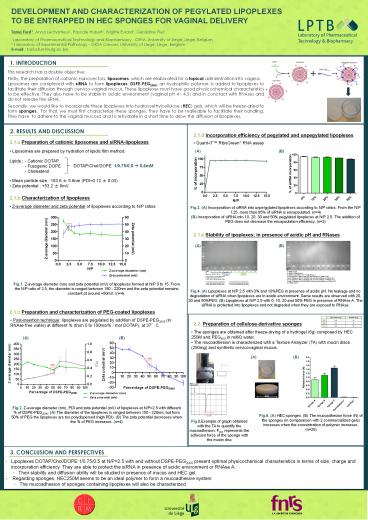Aucun titre de diapositive - PowerPoint PPT Presentation
1 / 1
Title:
Aucun titre de diapositive
Description:
DEVELOPMENT AND CHARACTERIZATION OF PEGYLATED LIPOPLEXES TO BE ENTRAPPED IN HEC SPONGES FOR VAGINAL DELIVERY ... Liposomes are complexed with siRNA to form lipoplexes. – PowerPoint PPT presentation
Number of Views:28
Avg rating:3.0/5.0
Title: Aucun titre de diapositive
1
DEVELOPMENT AND CHARACTERIZATION OF PEGYLATED
LIPOPLEXES TO BE ENTRAPPED IN HEC SPONGES FOR
VAGINAL DELIVERY
Tania Furst1, Anna Lechanteur2, Pascale Hubert2,
Brigitte Evrard1, Géraldine Piel1 1Laboratory of
Pharmaceutical Technology and Biopharmacy - CIRM,
University of Liege, Liege, Belgium 2 Laboratory
of Experimental Pathology - GIGA Cancer,
University of Liege, Liege, Belgium E-mail
tania.furst_at_ulg.ac.be
1. INTRODUCTION
This research has a double objective Firstly,
the preparation of cationic nanovectors,
liposomes, which are elaborated for a topical
administration into vagina. Liposomes are
complexed with siRNA to form lipoplexes.
DSPE-PEG2000, an hydrophilic polymer, is added to
lipoplexes to facilitate their diffusion through
cervico-vaginal mucus. These lipoplexes must have
good physicochemical characteristics to be
effective. They also have to be stable in acidic
environment (vaginal pH 4 - 4.5) and in conctact
with RNAses and do not release the
siRNA. Secondly, we would like to incorporate
these lipoplexes into hydroxyethylcellulose (HEC)
gels, which will be freeze-dried to form sponges.
For that, we must first characterize these
sponges. They have to be malleable to facilitate
their handling. They have to adhere to the
vaginal mucosa and to rehydrate in a short time
to allow the diffusion of lipoplexes.
.
2. RESULTS AND DISCUSSION
2.1.d Incorporation efficiency of pegylated and
unpegylated lipoplexes
2.1.a Preparation of cationic liposomes and
siRNA-lipoplexes
- Quant-iT RiboGreen RNA assay
- Liposomes are prepared by hydration of lipidic
film method - Lipids - Cationic DOTAP
- - Fusogenic DOPE
- - Cholesterol
- Mean particle size 163.6 5.6nm (PDI0.12
0.03) - Zeta potential 53.2 6mV.
(A)
(B)
2.1.b Characterization of lipoplexes
- Z-average diameter and zeta potential of
lipoplexes according to N/P ratios
Fig.3. (A) Incorporation of siRNA into
unpergylated lipoplexes according to N/P ratios.
From the N/P 1,25, more than 95 of siRNA is
encapsulated. (n4) (B) Incorporation of siRNA
into 10, 20, 30 and 50 pegylated lipoplexes at
N/P 2,5. The addition of PEG does not decrease
the encapsulation efficiency. (n3)
2.1.e Stability of ipoplexes in presence of
acidic pH and RNases
(A)
(B)
Fig.1. Z-average diameter (nm) and zeta potential
(mV) of lipoplexes formed at N/P 0 to 15. From
the N/P ratio of 2.5, the diameter is ranged
between 180 - 220nm and the zeta potential
remains constant at around 50mV. (n4).
Fig.4. (A) Lipoplexes at N/P 2,5 with 0 and
10PEG in presence of acidic pH. No leakage and
no degradation of siRNA when lipoplexes are in
acidic environment. Same results are observed
with 20, 30 and 50PEG. (B) Lipoplexes at N/P 2,5
with 0, 10, 20 and 50 PEG in presence of RNAse
A. The siRNA is protected into lipoplexes and not
degraded when they are exposed to RNAse.
2.1.c Preparation and characterization of
PEG-coated lipoplexes
HEC 250M (mg) PEG400 (mg)
A 100 25
B 200 25
C 200 50
- Post-insertion technique lipoplexes are
pegylated by addition of DSPE-PEG2000 (in RNAse
free water) at different (from 5 to 100mol /
mol DOTAP), at 37C.
2.2. Preparation of cellulose-derivative sponges
- The sponges are obtained after freeze-drying of
a hydrogel (6g) composed by HEC 250M and PEG400
in milliQ water. - The mucoadhesion is characterized with a Texture
Analyzer (TA) with mucin discs (250mg) and
synthetic cervicovaginal mucus.
Fig.2. Z-average diameter (nm), PDI and zeta
potential (mV) of lipoplexes at N/P2.5 with
different of DSPE-PEG2000. (A) The diameter of
the lipoplexes is ranged between 150 - 220nm, but
from 50 of PEG the lipoplexes are too
polydispersed (high PDI). (B) The zeta potential
decreases when the of PEG increases. (n4)
F min adhesion force
Fig.6. (A) HEC-sponges. (B) The mucoadhesion
force (N) of the sponges (in comparaison with 2
commercialized gels) increases when the
concentration of polymer increases. (n20)
Fig.5.Example of graph obtained with the TA to
quantify the mucoadhesion. Fmin represents the
adhesion force of the sponge with the mucin disc
3. CONCLUSION AND PERSPECTIVES
- Lipoplexes DOTAP/Chol/DOPE 1/0.75/0.5 at N/P2.5
with and without DSPE-PEG2000 present optimal
physicochemical characteristics in terms of size,
charge and incorporation efficiency. They are
able to protect the siRNA in presence of acidic
environment or RNAse A. - Their stability and diffusion ability will be
studied in presence of mucus and HEC gel. - Regarding sponges, HEC250M seems to be an ideal
polymer to form a mucoadhesive system - The mucoadhesion of sponges containing lipoplexes
will also be characterized.































